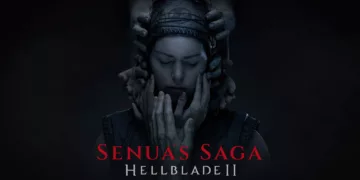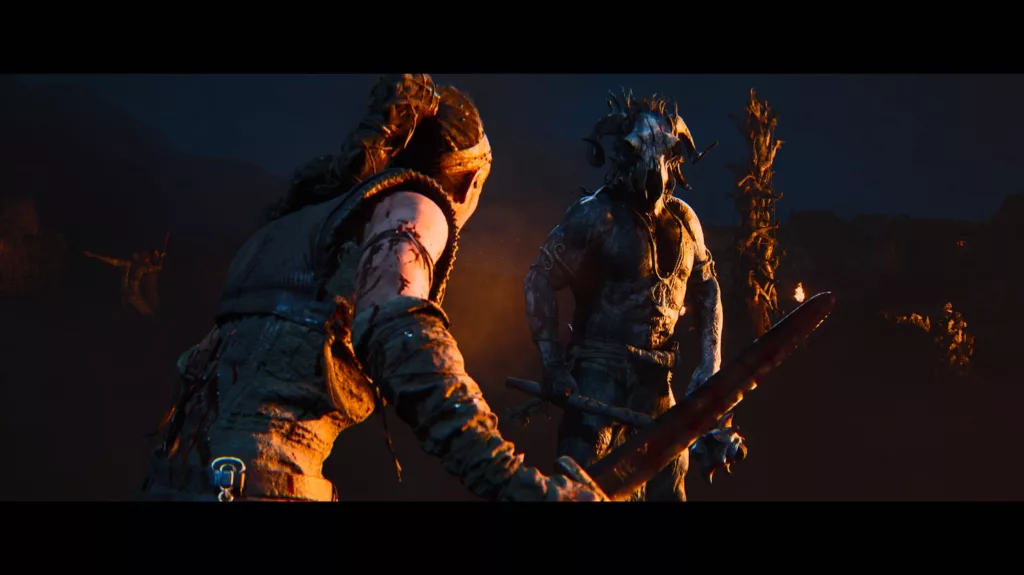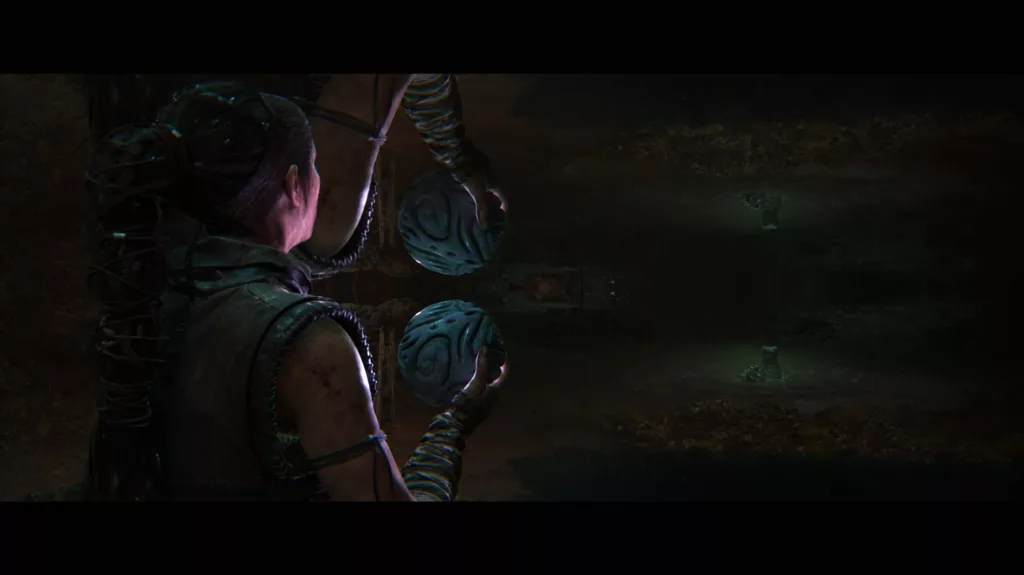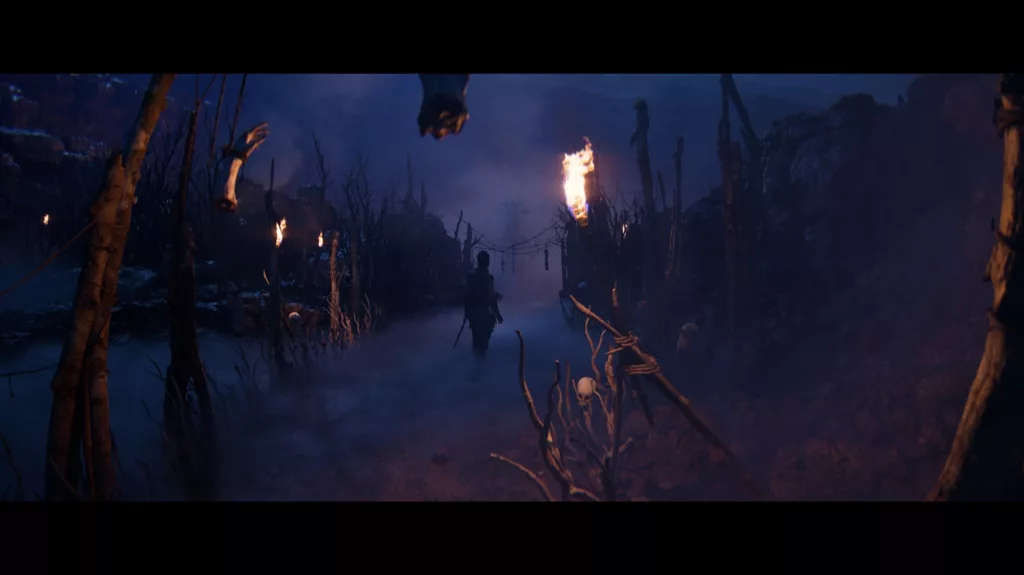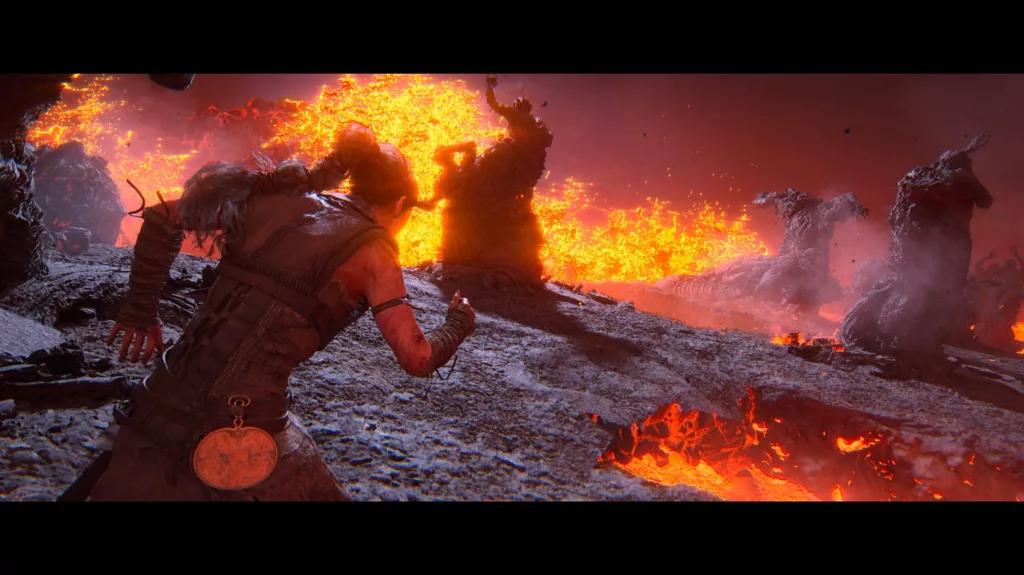After suffering immense trauma, Senua confronted her internal demons and found acceptance in the first Hellblade. As the game concluded, however, her homeland remained under threat from Norse invaders. Now in Hellblade II, Senua embarks on a new mission fueled by both vengeance and duty and finds herself in uncharted territory, quite literally. Stranded in Iceland after a shipwreck, she pushes ever forward to carry out her vow despite the unfamiliar and formidable landscape.
Ninja Theory continues crafting Senua’s harrowing journey with care and nuance. If the first entry delved into the depths of the human psyche, this sequel scales even greater heights. It expands Senua’s story into an epic worthy of its next-gen visuals while maintaining an intimate focus on her mental state.
Through encounters with giants and other unfathomable beings, Senua’s grip on reality is tested like never before, bringing the developer’s exploration of psychosis to shocking new realms. At the same time, refined gameplay ensures each fearful confrontation amounts to a cinematic thrill.
It’s a journey into the unknown for both Senua and the player. Through its jaw-dropping artistry and emotional grit, Hellblade II stands not only as a worthy successor but as a bold showcase of what new horizons can be reached when navigating the uncharted frontier of the human condition.
Senua’s Voyage of Discovery
Tragedy and devastation had forged Senua’s path in life, but now she walks it with purpose. While the voices in her head remained as vivid and unrelenting as ever, she had learned to embrace their cacophony rather than see them as a curse. Her homeland lay in ruins due to the raids of Norse slavers, and her dearest Dillion had been lost to their brutal rituals. Yet in confronting her demons in Helheim, Senua discovered the power of acceptance—of herself and her fate.
No longer would she be controlled by grief or shame. Vengeance would be her guide, as she allowed the slavers to take her north, deep into the realm of her enemies. But fate had other designs. A fierce storm scattered the ships, casting Senua ashore in a strange and icy land. Though stranded in this forbidding place, her mission now took on a on a new form. If she could not strike at the hearts of the slavers directly, then she would save those she could from their reach.
Here in Iceland, Senua found souls yet in need of liberation. And through their trials, she might find her own answers. Joined by an eclectic band of allies, Senua braved horrors known and unknown to protect the locals. But her hardest battles lay in aiding others to overcome trauma, just as she had. Leadership was a role untested for one long acquainted with isolation. In opening her heart to fellowship, however, Senua discovered inner strengths to match her formidable combat skills.
Through facing giants both within and without, her voyage became a journey of discovery. Senua would learn that by breaking the chains that bind others, our own are also loosened. And that salvation comes not from a single victory but through championing each other in life’s endless struggles. Her destiny, it seems, was not vengeance alone, but hope rekindled for all who suffered.
Hellblade 2’s Improved Battles
The combat sequences in Senua’s Saga: Hellblade 2 have received a refresh that makes skirmishes more engaging while retaining the core mechanics of the original. Fights unfold in intense 1v1 clashes as before, but enhanced visuals and camera work provide battles with a gripping cinematic flair.
Attacks feel weightier thanks to fluid, detailed animations. Landing a heavy strike has a real impact; the camera shakes to accentuate crushing blows. Perfectly timed parries are also gratifying, filling Senua’s focus meter and allowing her to unleash blazing counterattacks in slowed time. Visual cues make reading opponents clearer too, from the windup of powerful swings to tells for unblockable assaults.
Additional production values raise the tension as well. New adversaries crash into view fluidly to replace felled enemies, keeping combat challenging. Background events like retreating civilians and getting cut down add a sense of stake. Should Senua falter, quick respawns put her back in the fight without excessive penalties.
Elsewhere, overused “spot the rune” puzzles take a backseat to more varied puzzles. Intriguing tasks see Senua navigating dark spaces using torchlight or shifting mirrored realities. Curiosity is also rewarded through finding optional clues and side challenges tucked away off the beaten path.
While retaining familiar Demon’s Soul-style combat, these tweaks inject renewed energy into Hellblade 2’s battles. Stronger production values and puzzle diversions maintain momentum on the journey ahead.
Senua’s Psychosis Brought to Life
The visual and audio presentation of Hellblade 2 is nothing short of masterful. Ninja Theory leverages cutting-edge technology to bring the psychological and emotional turmoil of the protagonist, Senua, startlingly to life.
Character animation is of the highest caliber. Subtle facial movements convey deep emotions, while intricate motion capture ensures fluid body language. Action sequences portray visceral force through fluid combat motions. Melina Juergens again delivers a powerhouse performance as Senua, her facial details and mannerisms brimming with anguish, determination, and everything in between.
Real Icelandic landscapes scanned via photogrammetry populate breathtaking environments. Terrain stretches as far as the eye can see, immersing players in the forbidding Norse setting. Intricate lighting lends an ethereal touch, illuminating environments in a way that adds to the unsettling, surreal atmosphere. Surroundings shift seamlessly from day to night in a way that would rival Hollywood epics.
Then there is the audio. Hellblade 2 leverages 3D spatial sound for a next-level effect. Senua’s whispered demons surround and disorient, their taunts penetrating the mind as if your own thoughts. When reality blurs, an unnerving soundscape ushers in surreal sequences that enhance psychological torment. Epic battles boom with impact, while lonelier moments bring an unsettling stillness.
What truly distinguishes the presentation, however, is how it illustrates Senua’s fracturing psyche. Distorted visuals and unearthly lighting transport players alongside hallucinations. Dreamlike sequences see realities collide to portray inner conflict in a way that is at once artfully surreal yet grounded in Senua’s troubles. Like her trauma, it is impossible to look away.
Through its masterful audiovisuals, Hellblade 2 brings the psychological thriller to life unlike any other medium. It is a true technical marvel that will leave artists and audiences alike in awe.
Delving into Darkness with Care
The Hellblade series explores heavy themes that aren’t for the faint of heart. Senua’s ongoing struggles manifest in haunting hallucinations and a merciless internal chorus that would unsettle even the hardiest of minds. Yet Ninja Theory treats this delicate subject with nuance.
While the ghastly foes and twists of reality may induce shock, they reflect Senua’s unwavering journey towards acceptance. We witness her grow steadily in the storm of her psyche, and guidance is offered not as a complete solution but as another step on the path. Her allies’ troubles, too, find empathy. Though darkness permeates the dreamscape, light still guides the way.
Accessibility remains, but never at the expense of integrity or impact. Less stalwart players may opt to experience Senua’s story through a summary, yet they will still find veracity in its portrait of a mind pushing ever onward despite failings, real or perceived. Mechanics avoid complexity for drama’s sake, the better to immerse us in her plight.
Still, some conflicts could show more personality. While spectacles wow, varied patterns and unique adversaries might heighten tension. But such is a subtle tweak, not a crux complaint. Hellblade’s heart lies not in refining recipes for thrills but in crafting caring character studies that take us hand-in-hand into redemption’s most harrowing halls. Here is a series that delves into darkness, yet always with care.
Icescape Odyssey
Senua’s latest challenging journey builds captivatingly upon her first. Where the original delved deep into her trauma’s heart, this ventures boldly into terrifying new realms. Yet throughout, her resilience and humanity remain touchstones, guiding both hero and observer.
Ninja Theory again immerses us in Senua’s disturbing reality through spellbinding gameplay. Memorable faces share her struggles, while stunning vistas atop Iceland’s frigid plains inspire awe and fear. Battle’s violence carries weight, though it flows smoothly. Complex dilemmas find no easy answers under grim giants’ shadows.
This odyssey’s climax leaves mysteries unsolved. What nightmares await within her father’s symbol’s meaning? Further, will saving others help Senua finally find solace? Or will fresh terrors ever plague her restless mind? Only time will tell if her courage can outlast any demons, real or imagined, threatening the fellowship she now leads.
Regardless, Senua’s Saga proves again why Hellblade births continual discussion. Its craft breathes life into the unusual and fears within us all, reflecting reality’s complexity through one’s tortured soul’s eyes. By honoring mental illness’s real battles but refusing to label or conclude, Ninja Theory empowers more people to face their own darkness.
They establish a franchise at the edges of what games can convey through challenge, art, and heart. For now, we can only hope Senua’s uncompromising spirit continues guiding new realms’ exploration and that more learn from her example’s strength.
The Review
Senua's Saga: Hellblade II
While not without a few minor shortcomings, Hellblade II's masterful execution of its harrowing yet hopeful narrative through stunning visuals and considered systems makes for a profoundly memorable sequel experience. Senua's ongoing inner battles and the bleak beauty of her fictional worlds are brought to life with such artistry that it feels almost criminal to view them without the highest praise. Ninja Theory should be proud of how much they expanded upon their bold foundations while retaining the soul of what initially captured players.
PROS
- Stunning visuals and artistic design
- Thoughtful expansion of narrative and characters
- Engrossing audio design and voice acting
- Improved and varied combat and puzzle mechanics
- Maintains focus on mental health representation
CONS
- Psychotic voices sometimes drown out dialogue.
- Some combat encounters feel overly simplified.
- Narrative clarity suffers from disorienting cuts.
